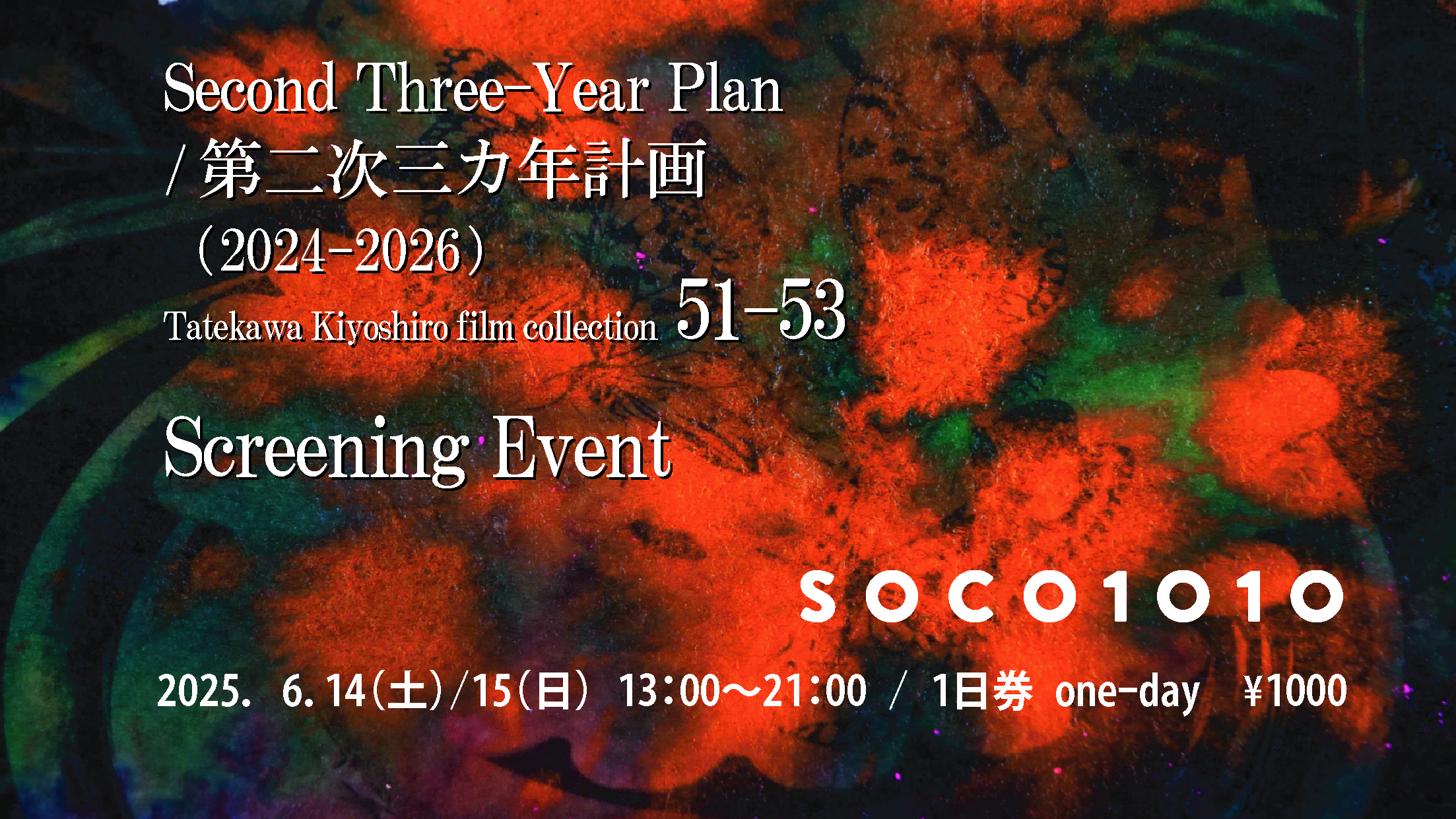
Second Three-Year Plan / 第二次三カ年計画(2024-2026)
Tatekawa Kiyoshiro film collection 51 – 53
この度soco1010では、昨年12月・本年3月に引き続き、映像作家の立川清志楼による「Second Three-Year Plan / 第二次三カ年計画(2024-2026)- film collection 51-53」のスクリーニングイベントを開催いたします。
本イベントは、2024年1月から稼働した「第二次三カ年計画」の一環として行われ、シングルスクリーンでの新作15本上映と作品消費の一例として作家自ら小型コンピューターと電子楽器を同時に駆使し過去作品の再構築を即興で試みます。また会場では上映作品及び過去作品を「1GB=10,000円」の量り売りで販売します。「生産→公開→流通→消費」のサイクルを構築し稼動させるシステム、それが「第二次三カ年計画」です。上映→販売→作品再構築を会場で目撃することでシステムの全容は明らかになります。継続的に進化を続ける「第二次三カ年計画」を是非ご覧ください!
soco1010 is pleased to announce the screening event “Second Three-Year Plan (2024-2026) – film collection 51-53” by filmmaker Seishiro Tachikawa, as we did in December last year and March this year.
This event is a part of the “Second Three-Year Plan” that started in January 2024. 15 new works will be screened on a single screen, and the artist himself will attempt to improvise a reconstruction of past works by simultaneously using a small computer and electronic instruments as an example of consumption of his works. In addition, the screened works and past works will be sold in quantities of “1GB=10,000 yen” at the venue. The “Second Three-Year Plan” is a system to construct and operate a cycle of “production → release → distribution → consumption. The full extent of the system will be revealed by witnessing the screening, sale, and reconstruction of the films at the venue. Please come and see the “Second Three-Year Plan” as it continues to evolve!
–
開催概要
日程|2025.06.14 [土] – 2025.06.15 [日]
会場|soco1010:東京都足立区千住橋戸町22-48
料金|1日券1000円(途中入退場自由)
お問合せ|https://tatekawa-kiyoshiro.com/category-contact/
–
主催|立川清志楼
協賛|Feb gallery Tokyo
–
Time Table
13:00-13:45 Tatekawa Kiyoshiro film collection 51
14:00-14:45 Tatekawa Kiyoshiro film collection 52
15:00-15:45 Tatekawa Kiyoshiro film collection 53
16:00-16:45 第一次及び第二次三カ年計画 REMIX VJ/Machine Live
17:00-17:45 Tatekawa Kiyoshiro film collection 51
18:00-18:45 Tatekawa Kiyoshiro film collection 52
19:00-19:45 Tatekawa Kiyoshiro film collection 53
20:00-20:45 第一次及び第二次三カ年計画 REMIX VJ/Machine Live
–
Statement
ミハイル・バフチンが「ドストエフスキーの詩学」で提唱したドストエフスキー文学におけるポリフォニーの手法(様々な立場・意見・人格の登場人物を自律的に対話させることで、作家以外の複数の視点が共存する物語を構成する)によって描かれる世界。錯綜する言葉から個々の概念を衝突させ混沌とした世界を描き出す、まさに文学ならではの表現法である。それでは映像におけるポリフォニーの手法とはどういうことか?映像そのものは物質を二次元に複写しているにすぎず、カメラは基本的にフレーム内の被写体しか捉えることは出来ない。映像とは本来限りなく唯物的であり、それのみで概念を誘発するには心もとない。そこで言葉・物語を映像に加え編集を施すことで映像は概念化することに成功した。映画の成功の歴史がそれを証明している。しかし、あえて言葉・物語を用いない映像ならではのポリフォニーをつくりだせないものだろうか?映像ならではの特質を生かした表現で唯物的に世界を描くのだ。だがその方法はすでに存在している。定点撮影、編集なしの初期映画作品、リュミエールの駅や工場風景は、より唯物的である。初上映時、映像の走る蒸気機関車から観客が逃げ出したエピソードはそれを証明する。リュミエールは世界各地に撮影者を派遣し約1500本の作品を残した。映画初期におけるリュミエールの仕事とは、まさに純粋な映像におけるポリフォニーの手法だった。それらは永遠の憧れであり目標である。
The world depicted by the method of polyphony in Dostoevsky’s literature, which Mikhail Bakhtin advocated in his “Dostoevsky’s Poetics,” is a story in which characters of various positions, opinions, and personalities interact autonomously to form a narrative in which multiple viewpoints other than the author coexist. This is truly a method of expression unique to literature that depicts a chaotic world through the collision of individual concepts from a complex language. What then is the polyphony technique in film? The image itself is nothing more than a two-dimensional reproduction of matter, and the camera can basically only capture the subject within the frame. Images are by nature infinitely materialistic, and are not enough to induce concepts on their own. Therefore, by adding words and stories to the image and editing it, the image has succeeded in becoming a concept. The history of successful films proves this. However, is it possible to create a polyphony that is unique to the visual image without using words or stories? The world can be portrayed in a materialistic way by making the most of the unique qualities of images. However, such a method already exists. Lumière’s early films, shot from a fixed point and unedited, are more materialistic in their depiction of train stations and factory scenes. The episode in which the audience ran away from the steam locomotive on which the film was running at the first screening is proof of this. Lumière dispatched cinematographers to various parts of the world and left behind about 1,500 films. Lumière’s work in the early days of cinema was truly a technique of pure visual polyphony. They are an eternal aspiration and goal.
–
About
第二次三カ年計画:
21世紀人間の意識から独立・巨大化したシステムにより運営されるこの社会を作家として生きていくためには自らが独立したシステムを構築し作家活動を継続する以外ない。既存システムへの迎合こそ作家活動の停滞を余儀なくしイニシアチブの放棄へと繋がる。いま作家自らによる新たなシステムの構築こそ必須であり、それが作家活動の根幹を成す。それは生産→公開→流通→消費と作品が絶えず循環するシステムであり、この可変的で安定的なシステムの稼働こそが作家活動の生命線となる。ここにシステムの維持・発展のため「第二次三カ年計画」を作成した。
1.月間5本の映像作品生産(年間60作品、3年間180作品)及び上映を目標とする。
2.作品時間は自由とし、全ての作品に実験的要素(構造・思考・方法)を取り入れること。
3.作品内容に関して、過去の自己作品及び他作品に対する類似性は問題としない。
4.生産作品については作家及び購入者において再編集・公開出来る自由を保証する。
5.永続的な活動システムの構築こそ最重要課題である。効率的な生産及び流通体系構築のため常にシステムを徹底的に合理化する。
2024年1月 立川清志楼
Second Three-Year Plan:
In order to survive as an artist in this 21st century society, which is run by a system that has become huge and independent from human consciousness, one has no choice but to build one’s own independent system and continue one’s activities as an artist. Complying with the existing system will lead to the stagnation of artists’ activities and the abandonment of initiative.It is essential for artists to build a new system on their own, which will form the foundation of their activities. It is a system in which works are constantly circulated through production, publication, distribution, and consumption, and the operation of this dynamic and stable system is the lifeline of the artist’s activity. The “Second Three-Year Plan” is hereby established for the maintenance and development of the system.
1.The goal is to produce and screen a minimum of 5 new video works per month (60 works per year, 180 works over 3 years).
2.The duration of the films is open-ended, and all films must incorporate experimental elements (structure, thought, method etc).
3.Similarity of the content of the works to past works of the applicant or to other works is not a problem.
4.the artist and the buyer are guaranteed the freedom to re-edit and publish the produced works after exchanging a written confirmation of the agreement.
5.The most important priority is the establishment of a permanent system of activity. The system will be thoroughly rationalized at all times in order to form an efficient production and distribution system.
Jan 2024 Kiyoshiro Tatekawa
–
立川清志楼|Kiyoshiro Tatekawa
写真家・映像作家。東京在住。 主に都市・動物園を撮影した映像に実験的要素を用いた編集を施し、物語性を排除した物質的な映像作品を制作する。作品のみならず上映方法についても複数のプロジェクターを用い紗幕へ投影するなど実験的なインスタレーションを実施している。2024年1月から実験映像プロジェクト第2弾「第二次三カ年計画」を稼働。毎月5本の映像作品を生産・上映することを目標とする。「写真新世紀2020年度優秀賞」(オノデラユキ選)、「写真新世紀2019年度佳作」(安村崇選)受賞。
Photographer and filmmaker based in Tokyo. Kiyoshiro’s subjects are mainly “zoos”. He uses experimental elements in his editing of images to produce material works that are detached from narrative. In recent years, He’s been experimenting with the methods of installing images using multi projections onto scrims. Excellence Award for Canon New Cosmos of Photography, 2020, selected by Yuki Onodera Excellence Award for Canon New Cosmos of Photography, 2021, selected by Takashi Yasumura
WEB:https://tatekawa-kiyoshiro.com/
Instagram:https://www.instagram.com/kiyo4ro/
–
▼下記事項をご確認の上ご来場いただきますようお願いいたします。
※会場に駐車場のご用意はございません。公共交通機関、もしくは周辺のパーキングをご利用ください。
※会期中のカフェの営業はいたしません。
※状況により入場制限を行う場合がございます。
※内容は予告なく変更する可能性がございます。ご了承ください。
※予告なく会期直前、もしくは会期中の延期・中止の可能性がございます。ご了承ください。
–
▼下記に該当される方につきましてはご来場をお控えいただきますようお願いいたします。
※体調にご不安のある方(発熱、咳、倦怠感、等の症状等)のご来場はご遠慮下さい。
Copyright©2020 soco1010 All rights reserved.